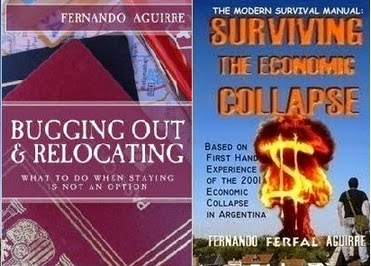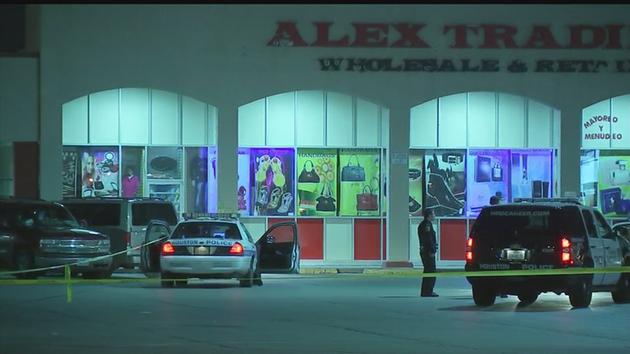(Folks, in case you haven’t read it, here’s the link to part I)It
is sad to see many of the problems Argentina has been experiencing
after its economic collapse becoming more common in developed countries
around the world. The world isn’t about to end, we’re not donning our
leather jackets and holstering a sawed-off shotgun as we head to the
Australian wasteland, but the world has changed, hasn’t it? When people
ask me when did Argentina change from what it used to be to what it is
now, I tell them that other than certain specific incidents, such as
rioting, corruption scandals, resignations and defaults, there really
wasn’t a specific date. You just wake up one day or contemplate the
reality around you one day and you go “Damn, what the hell happened to
us?” You see dollar-tree stores where you used to have bookstores, you
see take-away joints of dubious quality where you once had fine
restaurants. Malls close down or are left half deserted, with few
patrons walking about. You see more people begging, the colors of the
clothes worn fading as they get older and aren’t replaced with new ones,
you see the stern faces, and then it hits you. You’re no longer living
in the same place.
The purpose of this series of posts is to help you
understand what may already be happening in your city and what is
likely to happen in the future. Argentina’s economy collapsed in 2001.
Today, experts mostly agree that the global economic crisis started in
2008, so Argentina has a seven year head start. Granted, hopefully your
country won’t fall as hard as Argentina did, but you’ll see the
similarities on almost all categories to a greater or lesser degree.
Infrastructure
As the economy suffers, so does the infrastructure. Everything from
roads, power lines, sewers, flood prevention, traffic signaling,
buildings, parks, bridges, it all requires constant maintenance. This is
of course very expensive, and one of the more obvious signs of bad
economic times is bad infrastructure all around. Anyone that ever
traveled to the 3rd world has probably seen it: There’s not much urban
coherence, everything seems to be just thrown together without
consultation and a total lack of planning. Power, TV and phone cables
hang over your head in all directions. Just like power fails each
summer, communications aren’t very reliable either. Public buildings are
in particularly poor shape. Ironically enough, this is the University
of Buenos Aires, where I studied Architecture.

There’s no central heating or air conditioners, the elevator is
famously dangerous when it works and the toilets are in pitiful
condition. You have to get there on time to find a bench to sit on and
you better keep an eye on your belongings because they will get stolen
right in front of you.
Floods and other DisastersThe
problem is again, lack of investment and infrastructure. There’s no
money to train and keep enough rescue personnel. There’s practically
nothing done in terms of prevention and education. Everything from
widespread rioting to wildfires and pandemics, it’s all handled poorly
to say the last.
Regarding floods, there’s enormous amounts of
litter on the streets which clog storm drains. Storm drains are also
made of pretty heavy metal so… remember the inflation problems, along
with crime and unemployment mentioned in Part I? Storm drain grated
inlets are usually made of heavy iron. That iron fetches a nice price
when sold, so these are constantly being stolen all over the country.
Everything from statues, historic plaques in monuments and even
doorknobs have been stolen because of the price of metals.
If flood
prevention investment is a problem in developed nations, you can imagine
how bad it gets in a place like Argentina. Without hurricanes or even
serious storms, just heavy rain is enough to end in tragedy.

In
April 2013 a flood in the capital city La Plata claimed over 100 lives.
As years go by and the infrastructure is not only not upgraded but
keeps deteriorating, floods are yet another problem people in Buenos
Aires have to deal with.
This problem is
already occurring in USA.
Terrorism ThreatLess
money also means less security on the borders. In the case of Argentina
the problem was twofold. On one hand there not even an attempt to
secure the borders, so anyone walks into the country. On the other hand
there’s no political intention to do so either. People from Bolivia,
Peru and Paraguay, the poorest northern neighbors, just walk into the
country, get a local ID and sign up to collect benefits. They of course
vote with this in mind, so the current Kirchner government knows that
each immigrant vote is a vote for them. My wife for example, she had to
renew her national ID. She waited in line for several hours and was
handed a number, told to come back the following day. At the same time
and right next to her line was another one for immigrants. Their line
moved quicker and they got their ID the same day. Why does it take
longer to renew an existing ID for a citizen while an immigrants with
nothing to his name gets and entire citizenship registration and ID
documents issued immediately? Because it was elections time and they
wanted to make sure all the immigrants from Peru, Bolivia and Paraguay
had their papers ready to vote. Maybe the Americans reading this can
find some similarities here too.
Argentina is no stranger to terrorist attacks.

In
1994 the Argentine Israelite Mutual Association was attacked with a car
bomb, 85 people were killed. The Israeli embassy in Buenos Aires had
already been bombed in 1992, leaving 29 people dead. These attacks have
never been solved, and there’s an ongoing scandal involving the Kirchner
government and the Iranian government who apparently plotted together
to protect those responsible. Corruption, lack of funding and negligence
provide greater opportunities for terrorists. For countries with an
interventionist foreign policy, the risk is even greater and this should
be considered as a potential risk in years to come, especially in
emblematic cities and locations.
Culture and Society

Just
like the infrastructure falls apart, so does culture. The changes here
aren’t immediate, but they are visible. You notice people being more
rude in general, but also less educated and more primitive than they
used to be, which is quite sad. With the increased poverty you see a
clear deterioration of culture in general. While there are honorable
attempts in the field of arts, the lack of funds means artistic
education and investment suffers greatly in spite of the good intentions
of many. You can see some buzz regarding street arts, informal dance
and improvisation, but in general a financial crisis will impact culture
greatly. The need to earn a living becomes a top priority for most.
People
that used to travel abroad find it harder to do so. Fashion, ideas
regarding arts and design, it’s all less available than it used to be.
Books for example, they become harder and harder or get. Five years ago
when I traveled abroad I ended up bringing back two suitcases to
Argentina. One of them was full of books. Thanks to the import
restrictions, books have become very expensive in Argentina and the
offer available is pretty limited. If you try ordering online you’ll
find yourself having to travel to the international airport to pick it
up from customs. You’ll also have to pay a 50% extra fee for importation
and you’ll have to waste most of your day waiting in line to get it.
Little by little, you see people becoming more ignorant and it shows.
It
takes a bit longer, but after 14 years you can see an entire generation
that basically grew up knowing only the post collapse Argentina, barely
recognizing the shadows of what was once the most sophisticated and
culturally rich country in Latin America. Most 20 year old can barely
read and write, if lucky, and those that consider themselves
intellectuals simply regurgitate the Marxist nonsense they’ve been
indoctrinated with thanks to the public education programs.
MediaIn
many ways the media reflected what was happening to society and
culture. Sensationalism became more common in news reports. It didn’t
help that the level of violence was already bad. With people getting
killed and kidnaped on daily basis it kept getting harder and harder to
shock the viewer. Eventually you didn’t pay much attention to the news
because it repeated itself so much. The state managed TV channel became
completely worthless, just a channel for propaganda that never actually
reported anything. As time went by we saw the government adopt a new
strategy: Buy or nationalize channels and various media that wasn’t in
tune with the government. Eventually they regulated this strategy of
theirs with a new media and telecommunications law passed in 2009. Only
two media companies of relevance are left in the country that aren’t
directly or indirectly controlled by the government. Censorship has
drastically increased in Argentina in the last decade. Not only does the
government control most printed media, radio and tv channels, those
they don’t control are constantly harassed and journalists are
threatened or attacked. The fear of speaking against the government is
one of the worst tragedies and should be considered an important red
flag to look for.
PoliticsNestor Kirchner
reached the presidency of Argentina in 2003 exclusively thanks to the
endorsement of Eduardo Duhalde, a Peronist politician with great power
in Buenos Aires who had stepped up after Fernando de la Rua resigned and
four other politicians resigned after taking the job. Just a few months
after Kirchner was elected, it was soon clear that a very corrupt and
authoritarian person had been placed in power, a typical Peronist
populist leader.
The Kirchner government was particularly bad for
the country for several reasons, but most of all because of its extreme,
in your face corruption. Nestor Kirchner wasn’t the first corrupt
president the country had ever seen, but he sure was the worst, the
least shameful about it and the one that has robbed the most. Contracts
would be handed over to the president’s own business associates. Public
money would be shamelessly sent abroad to privately owned accounts “for
safe keeping”. Family and friends would be placed in key, high ranking
government positions in spite of having no qualifications at all for the
job, the most extreme case of this being his own wife Cristina Kirchner
taking office after his first period ended.
During hard economic
times, during troubled sociopolitical events, extra caution should be
taken so as to not place populist politicians in strategic positions,
especially the presidency. This type of politician is the opposite of
the honest , professional one actually qualified for the job.
If you have any comments of questions, leave them below. Part III will be posted later this week.
FerFAL
Fernando “FerFAL” Aguirre is the author of “The Modern Survival Manual: Surviving the Economic Collapse” and “Bugging Out and Relocating: When Staying is not an Option”.






















